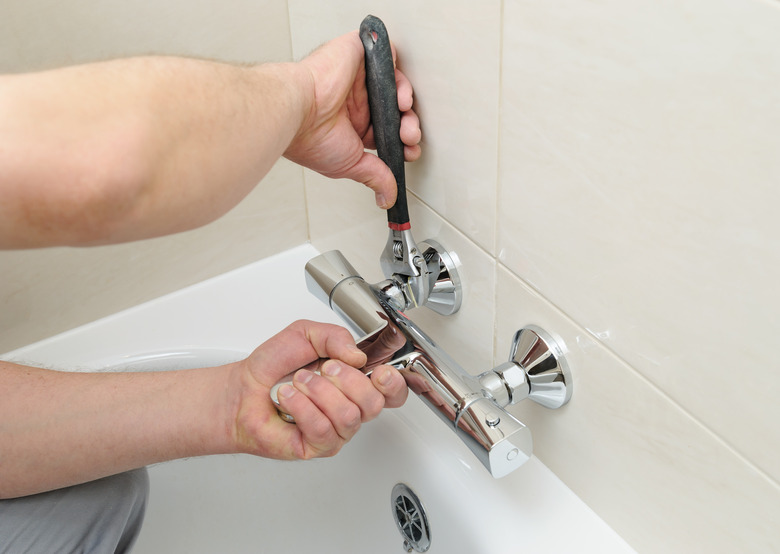How To Fix A Leaky Tub Faucet
We may receive a commission on purchases made from links.
A leaky tub faucet is annoying, but luckily the fix is almost always a very simple DIY: swapping out a worn-out washer, gasket, or O-ring. Even if you don't consider yourself a home improvement whiz, this repair is easy enough for most homeowners to get done in about an hour or two.
Occasionally, however, a bathtub faucet leak is caused by a damaged valve, and in very rare cases, there's a rupture in the pipes, which are behind the wall and often inaccessible without some demolition. You need a plumber for this repair, but thankfully, it almost never happens.
Ideally, the procedure for replacing a bathroom faucet washer, gasket, or O-ring doesn't take much time, but things don't always go smoothly. If you have hard water and the faucet hasn't been serviced for several years, there's a good chance the faucet handle is stuck to the valve stem or the valve itself is welded to the valve housing. When you can't remove the handle or valve by pulling with your finger or a pair of pliers, you need the help of heavier duty tools like a handle puller or valve pullers.
Check for a Leak Behind the Wall
Check for a Leak Behind the Wall
The part of the tub faucet you can see from the bathroom is the tip of the proverbial iceberg. The actual valve housing, which is where cold and hot water are directed to the tub spout and showerhead, is permanently connected to the water pipes behind the tub wall. A typical setup consists of cold and hot water inlet pipes — usually 1/2-inch copper or PEX — leading to the valve, a copper pipe extending from the valve to the tub spout, and another copper pipe that goes to the showerhead. These parts don't usually leak, but they can.
If the bathroom plumbing is well designed, there's a panel behind the tub wall that allows access to the valve, and if you see water on the floor, you should definitely check inside this panel for signs of a leaking valve or leaking pipes. If you see water spraying, your best bet is to call a plumber as soon as possible before the water has a chance to damage the wall framing or floor. If there's no panel, signs of water on the floor around the base of the wall or the bathtub are all the evidence you need to get on the phone.
Single-, Double-, and Triple-Handle Faucets
Single-, Double-, and Triple-Handle Faucets
Like sink faucets, tub and shower faucets can be operated by one of four different valve mechanisms. The most common is a cartridge — a barrel-shaped insert with strategically placed holes that control the flow of water when you turn the handle. Bathtub faucets with cartridge valves usually have one handle, but they can have two. When a double-handle faucet has cartridge valves, you can only turn the handles through 90 degrees.
Most double-handle tub faucets have compression valves, which are the type that screw down onto the valve seat when you turn the handle clockwise and let water flow when you turn counterclockwise. Older compression valve bathroom faucets sometimes have a third handle to operate a diverter that switches water flow from the tub spout to the showerhead. The diverter is hardly ever responsible for a leak from the spout, however, so you don't have to worry about it.
The other two types of faucets — those with disk valves and those with ball valves — are more common on sink faucets than on tub faucets. Delta, the company that introduced ball valves, stopped supplying them on tub faucets in the 1990s, so your faucet has to be pretty old and have a single handle to have a ball valve. Disk valves are more common in tub faucets than ball valves, and if your single- or double-handle faucet happens to have them, you're in luck because they seldom leak and are easier to repair than other types of valves.
Getting Ready to Replace a Washer
Getting Ready to Replace a Washer
Replacing washers and gaskets to stop your tub faucet from leaking will take less time if you're ready with replacement parts before you start disassembly, and all you need to have those on hand is the make and model of the faucet. You can usually identify the manufacturer by the logo on the cap that hides the handle screw, or the manufacturer's name may be displayed on the faucet escutcheon (aka the metal piece that hides the hole in the wall where the pipe is). One you know the manufacturer, you can search its website for your particular model and take that information to the hardware store to find a model-specific repair kit.
If the faucet has mineral deposit stains, there's a good chance the handle or valve is going to be stuck, so you might want to invest in a handle puller and, if you have a cartridge faucet, a cartridge puller. These are handy tools to have around the house and will usually work on other faucets as well as the one that's presently in need of repair. While you're at the hardware store, purchase some plumbers' grease so you can lubricate the rubber parts you're replacing.
You need to turn off the water supply to the bathroom, and if you're like a lot of homeowners, you probably have no idea where the shutoff valve is located. Look for one in the basement underneath the bathroom or look for a main valve near the point of entry of the main water line into the house. In some cases, the valve is outside on the side of the house. If you can't find a valve, you may have to turn off the one on the street but call the water company before you do that. There may be a rule prohibiting homeowners from shutting it off, and to avoid liability in case something breaks, you'll have to schedule a worker to come and shut it off for you.
How to Fix a Leaky Bathtub Faucet
How to Fix a Leaky Bathtub Faucet
The repair procedure begins with shutting off the water to the bathroom. Once you've done that, you're ready to begin.
1. Determine Which Valve Needs Servicing
If the faucet has a single handle, it has only one valve, and that's the only one you need to worry about. If the faucet has two handles, only one of the valves may need servicing. Feel the temperature of the water that's dripping from the spout. If it's warm, service the hot water valve first, and if it's cold, start with the cold water valve. If the faucet still leaks after you service the hot or cold valve, you can service the other one, but you might not have to do so.
2. Remove the Faucet Handle
Pry off the cap hiding the handle screw using a flathead screwdriver. The setscrew for lever-style faucets is usually right under the lever. Once you get the cap off, remove the setscrew with a Phillips screwdriver or Allen wrench. Once the screw is removed, you should be able to pull the handle straight off. If it doesn't come off easily, use the handle puller that you purchased beforehand.
3. Release the Valve
The procedure for releasing the valve depends on the faucet type:
- A compression valve is held in place by a retaining nut that you can unscrew with a pair of slip-joint pliers or an adjustable wrench.
- A ball valve also has a retaining nut that you can unscrew with pliers. Once the nut is off, the ball will literally fall out of the valve housing.
- A cartridge valve may be held by a retaining nut or a clip that you remove with a pair of needle-nose pliers. Depending on the model, you may have to pull off a temperature limiting ring and a stop tube and remove the faucet escutcheon before you can get to the retaining clip or nut.
- A disk valve is usually held in place by screws that you can remove with a Phillips screwdriver.
4. Pull Out the Valve
If you have a cartridge valve, grasp the valve stem with pliers and pull the cartridge straight out of the housing. If the cartridge is stuck, don't wiggle it excessively or you could damage the valve housing. Use a cartridge puller to get it out.
5. Check the Valve
Cartridge and ball valves are often made of plastic, and the plastic can chip or crack. If you see any defects on the valve, replace it with a new one. If the valve is caked with scale but has no other defects, the scale may be causing the leak. Clean the valve by soaking it in vinegar for a few hours.
6. Replace All Rubber Parts
The rubber parts that you need to replace also depend on the type of faucet you have:
- A compression valve has a single rubber washer on the end of the valve stem. Remove the screw holding it with a Phillips screwdriver and replace it with an identical one.
- A ball valve has a spring-loaded seat washer in each of the water inlets in the valve seat. Pry out both washers and springs with a screwdriver and replace them. Use the screwdriver to seat them and push them in.
- A cartridge valve has one or more O-rings that you can slip off the cartridge and replace. It's a good idea to lubricate the O-rings with plumbers' grease before you slip them on. There may also be a seat washer in each of the water inlet holes inside the valve housing. Check with a flashlight and if you see washers, replace those too.
- A disk valve usually has a pair of gaskets in the water inlet holes in the valve seat. Pull them out with a screwdriver or needle-nose pliers and replace them.
7. Reassemble the Faucet
Put a little plumbers' grease on your finger and lubricate the inside of the valve housing. Then, lubricate the valve itself and put it back into the valve housing. Reassemble the faucet by reversing the steps you used to take it apart.
8. Test the Faucet
Turn on the water and watch the bathtub spout to see if it drips. If it doesn't, you're finished. If it does and you have a compression faucet, service the other valve.
Servicing the Valve Seat
Servicing the Valve Seat
If a tub faucet continues to leak after you've replaced all the rubber, the fault may be with the valve seat. It could be cracked or damaged by corrosion. To replace it, turn off the water, disassemble the faucet, and use a seat wrench (which looks like a bent Allen wrench) to unscrew and remove the valve seat. Take the seat to the hardware store and purchase an identical replacement. Screw it in place with the seat wrench and reassemble the faucet.

